Seabed Liquefaction around Pipeline with Backfilling Trench Subjected to Strong Earthquake Motions
Abstract
1. Introduction
2. Research Method
2.1. Governing Equation
2.2. Constitutive Model
2.3. Method Validation
3. Numerical Analysis Model
3.1. Model Construction
3.2. Model Input Selection
4. Results and Discussion
4.1. Liquefaction Initiation of Seabed around the Trenched Pipeline
4.2. Liquefaction-Induced Uplift of the Pipeline with Backfilling Trench
5. Conclusions
- (1)
- Seismic loading leads to a rise in excess pore water pressure and liquefaction in seabed soil and the wave and current contributes to the periodic oscillation in the rise in excess pore water pressure in the seabed soil. Following seabed liquefaction, the pore water flows upward and the seabed is, thereby, reconsolidated.
- (2)
- Compared with the case without trench backfilling, the excess pore water pressure rises more slowly in trench backfilling under seismic loading and no liquefaction occurs. The liquefaction of seabed soil at the pipeline bottom is mitigated due to the existence of trench backfilling.
- (3)
- The seismically induced liquefaction leads to the uplift of the pipeline. The uplift of the pipeline lags behind the accumulation of excess pore water pressure at the surrounding seabed soil, which occurs following seabed liquefaction.
- (4)
- The existence of trench backfilling reduces the uplift of the pipeline and eliminates the oscillation caused by ocean wave and current during the uplift process.
Author Contributions
Funding
Institutional Review Board Statement
Informed Consent Statement
Data Availability Statement
Acknowledgments
Conflicts of Interest
References
- Cheng, A.H.D.; Liu, P.L.F. Seepage force on a pipeline buried in a poroelastic seabed under wave loading. Appl. Ocean Res. 1986, 8, 22–32. [Google Scholar] [CrossRef]
- Dunn, S.L.; Vun, P.L.; Chan, A.H.C.; Damgaard, J.S. Numerical modelling of wave-induced liquefaction around pipelines. J. Waterw Port. Coast. Ocean Eng. 2006, 132, 276–288. [Google Scholar] [CrossRef]
- Gao, F.P.; Yan, S.; Yang, B.; Luo, C. Steady flow-induced instability of a partially embedded pipeline: Pipe-soil interaction mechanism. Ocean Eng. 2011, 38, 934–942. [Google Scholar] [CrossRef]
- Magda, W. Wave-induced uplift force acting on a submarine buried pipeline in a compressible seabed. Ocean Eng. 1997, 24, 551–576. [Google Scholar] [CrossRef]
- Sawicki, A.; Mierczyński, J. Developments in modelling liquefaction of granular soils caused by cyclic loads. Appl. Mech. Rev. 2006, 59, 91–106. [Google Scholar] [CrossRef]
- Sumer, B.M.; Truelsen, C.; Fredsøe, J. Liquefaction around pipelines under waves. J. Waterw Port. Coast. Ocean Eng. 2006, 132, 266–275. [Google Scholar] [CrossRef]
- Sumer, B.M. Liquefaction around Marine Structures: (With CD-ROM); World Scientific: London, UK, 2014. [Google Scholar]
- Teh, T.C.; Palmer, A.C.; Damgaard, J.S. Experimental study of marine pipelines on unstable and liquefied seabed. Coast. Eng. 2003, 50, 1–17. [Google Scholar] [CrossRef]
- Teh, T.C.; Palmer, A.C.; Bolton, M.D.; Damgaard, J. Stability of submarine pipelines on liquefied seabeds. J. Waterw Port. Coast. Ocean Eng. 2006, 132, 244–251. [Google Scholar] [CrossRef]
- Ulker, M.; Rahman, M.S.; Guddati, M.N. Wave-induced dynamic response and instability of seabed around caisson breakwater. Ocean Eng. 2010, 37, 1522–1545. [Google Scholar]
- Zhao, H.Y.; Jeng, D.S. Accumulated Pore Pressures around Submarine Pipeline Buried in Trench Layer with Partial Backfills. J. Eng. Mech. 2016, 142, 04016042. [Google Scholar] [CrossRef]
- Zhao, K.; Xiong, H.; Chen, G.X.; Zhao, D.F.; Chen, W.Y.; Du, X.L. Wave-induced dynamics of marine pipelines in liquefiable seabed. Coast. Eng. 2018, 140, 100–113. [Google Scholar] [CrossRef]
- Zhao, K.; Wang, Q.Z.; Chen, S.; Zhuang, H.Y.; Chen, G.X. Dynamic response of pipelines in liquefiable seabed under nature loadings: Waves and currents. Ocean Eng. 2021, 230, 109051. [Google Scholar] [CrossRef]
- Zhao, K.; Zhu, S.D.; Bai, X.X.; Wang, Q.Z.; Chen, S.; Zhuang, H.Y.; Chen, G.X. Seismic response of immersed tunnel in liquefiable seabed considering ocean environmental loads. Tunn. Undergr. Space Technol. 2021, 115, 104066. [Google Scholar] [CrossRef]
- Nath, B.; Soh, C.H. Transverse seismic response analysis of offshore pipelines in proximity to the sea-bed. Earthq. Eng. Struct. Dyn. 1978, 6, 569–583. [Google Scholar] [CrossRef]
- Datta, T.K.; Mashaly, E.A. Seismic Response of Buried Submarine Pipelines. J. Energy Resour. Technol. 1988, 110, 208–218. [Google Scholar] [CrossRef]
- Yan, Y.F.; Cheng, L.F. The Finite Element Analysis on the Submarine Pipeline under the Seismic Loading. Adv. Mater. Res. 2012, 1700, 490–495. [Google Scholar] [CrossRef]
- Deng, Y.L.; Bian, Y.; Lei, F. Seismic Response Analysis of Free Long-Span Submarine Flexible Pipelines under Earthquakes. In Applied Mechanics and Materials; Trans Tech Publications Ltd.: Stafa-Zurich, Switzerland, 2014; Volume 580, pp. 1704–1707. [Google Scholar]
- Luan, M.T.; Zhang, X.L.; Yang, Q.; Guo, Y. Numerical analysis of liquefaction of porous seabed around pipeline fixed in space under seismic loading. Soil Dyn. Earthq. Eng. 2009, 29, 855–864. [Google Scholar]
- Li, B.; Wang, F.M.; Fang, H.Y.; Yang, K.J.; Zhang, X.J.; Ji, Y.T. Experimental and numerical study on polymer grouting pretreatment technology in void and corroded concrete pipes. Tunn. Undergr. Space Technol. 2021, 113, 103842. [Google Scholar] [CrossRef]
- Miao, Y.; He, H.; Liu, H.; Wang, S.Y. Reproducing ground response using in-situ soil dynamic parameters. Earthq. Engng. Struct. Dyn. 2022, 51, 2449–2465. [Google Scholar] [CrossRef]
- Wang, S.Y.; Zhuang, H.Y.; Zhang, H.; He, H.J.; Jiang, W.P.; Yao, E.L.; Ruan, B.; Wu, Y.X.; Miao, Y. Near-surface softening and healing in eastern Honshu associated with the 2011 magnitude-9 Tohoku-Oki Earthquake. Nat. Commun. 2021, 12, 1215. [Google Scholar] [CrossRef] [PubMed]
- Zhao, K.; Wang, Q.Z.; Chen, Q.; Zhuang, H.Y.; Chen, G.X. Simplified effective stress modeling of shear wave propagation in saturated granular soils. Géotechnique Lett. 2021, 11, 2045–2543. [Google Scholar] [CrossRef]
- Zhao, K.; Wang, Q.Z.; Zhuang, H.Y.; Li, Z.Y.; Chen, G.X. A fully coupled flow deformation model for seismic site response analyses of liquefiable marine sediments. Ocean Eng. 2022, 251, 111144. [Google Scholar] [CrossRef]
- Byrne, P.M. A cyclic shear–volume coupling and pore pressure model for sand. In Proceedings of the 2nd International Conference on Recent Advances in Geotechnical Earthquake Engineering and Soil Dynamics, St. Louis, MI, USA, 3 January 1991; pp. 47–55. [Google Scholar]
- Chen, G.X.; Zhao, D.F.; Chen, W.Y.; Juang, C.H. Excess Pore-Water Pressure Generation in Cyclic Undrained Testing. J. Geotech. Geoenviron. Eng. 2019, 145, 7. [Google Scholar] [CrossRef]
- Ishihara, K. Liquefaction and flow failure during earthquakes. Géotechnique 1993, 43, 351–415. [Google Scholar] [CrossRef]
- Zhao, K.; Qin, Y.; Lu, Q.R.; Chen, W.Y.; Zhuang, H.Y.; Chen, G.X. Cyclic resistance of saturated silt under wave-induced non-proportional loading. Appl. Ocean Res. 2020, 102, 102296. [Google Scholar] [CrossRef]
- Chen, G.X.; Ruan, B.; Zhao, K.; Chen, W.Y.; Zhuang, H.Y.; Du, X.L.; Juang, C.H. Nonlinear response characteristics of undersea shield tunnel subjected to strong earthquake motions. J. Earthq. Eng. 2020, 24, 351–380. [Google Scholar] [CrossRef]
- Day, R.A.; Potts, D.M. Zero thickness interface elements—Numerical stability and application. Int. J. Numer. Anal. Methods Geomech. 1994, 18, 689–708. [Google Scholar] [CrossRef]
- Itasca Flac—Fast Lagrangian Analysis of Continua; Version 6; Itasca Consulting Group, Inc.: Minneapolis, MI, USA, 2009.
- Hsu, H.C.; Chen, Y.Y.; Hsu, J.R.C.; Tseng, W.J. Nonlinear water waves on uniform current in lagrangian coordinates. J. Nonlinear Math. Phys. 2009, 16, 47–61. [Google Scholar] [CrossRef]

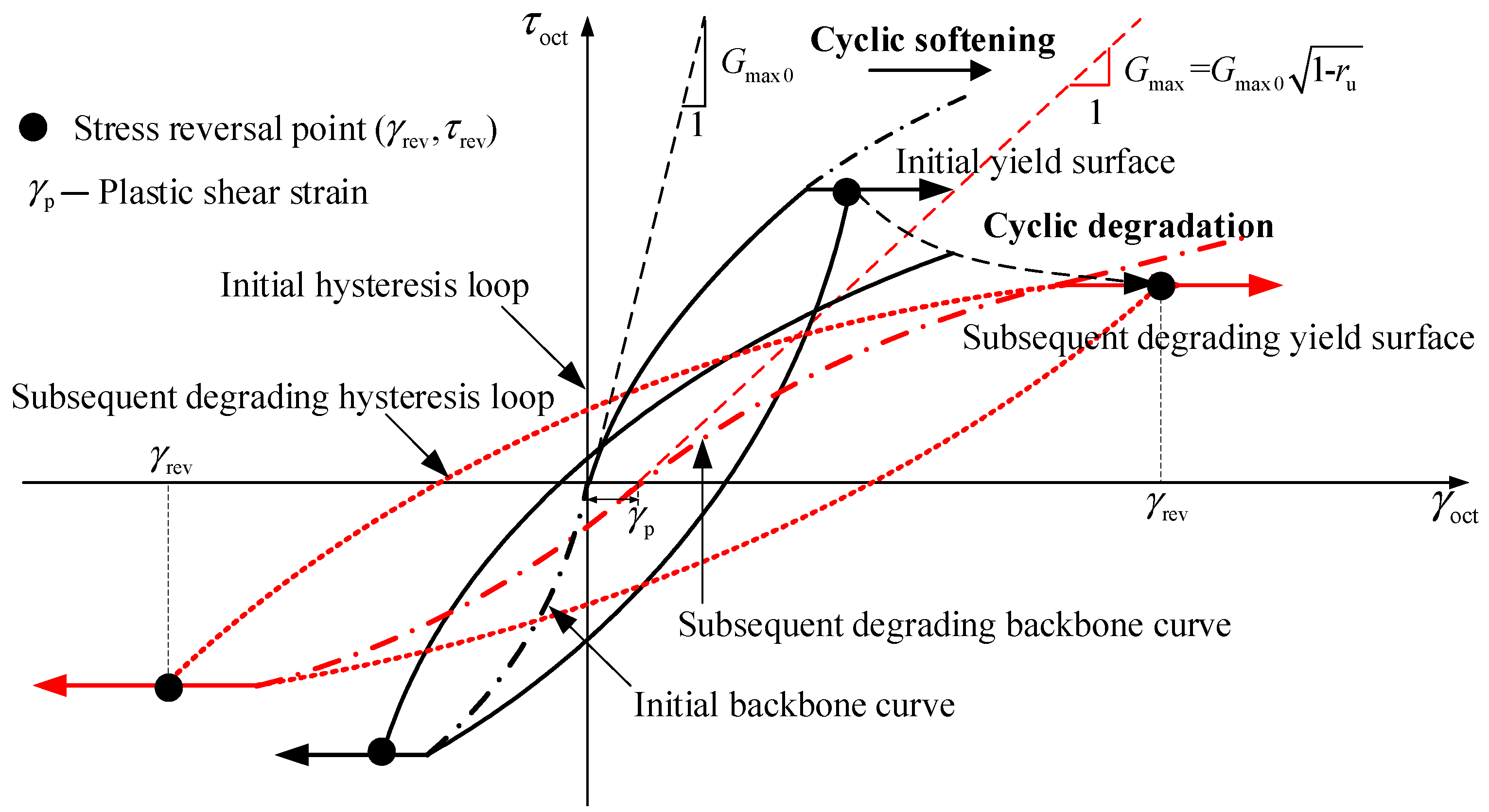

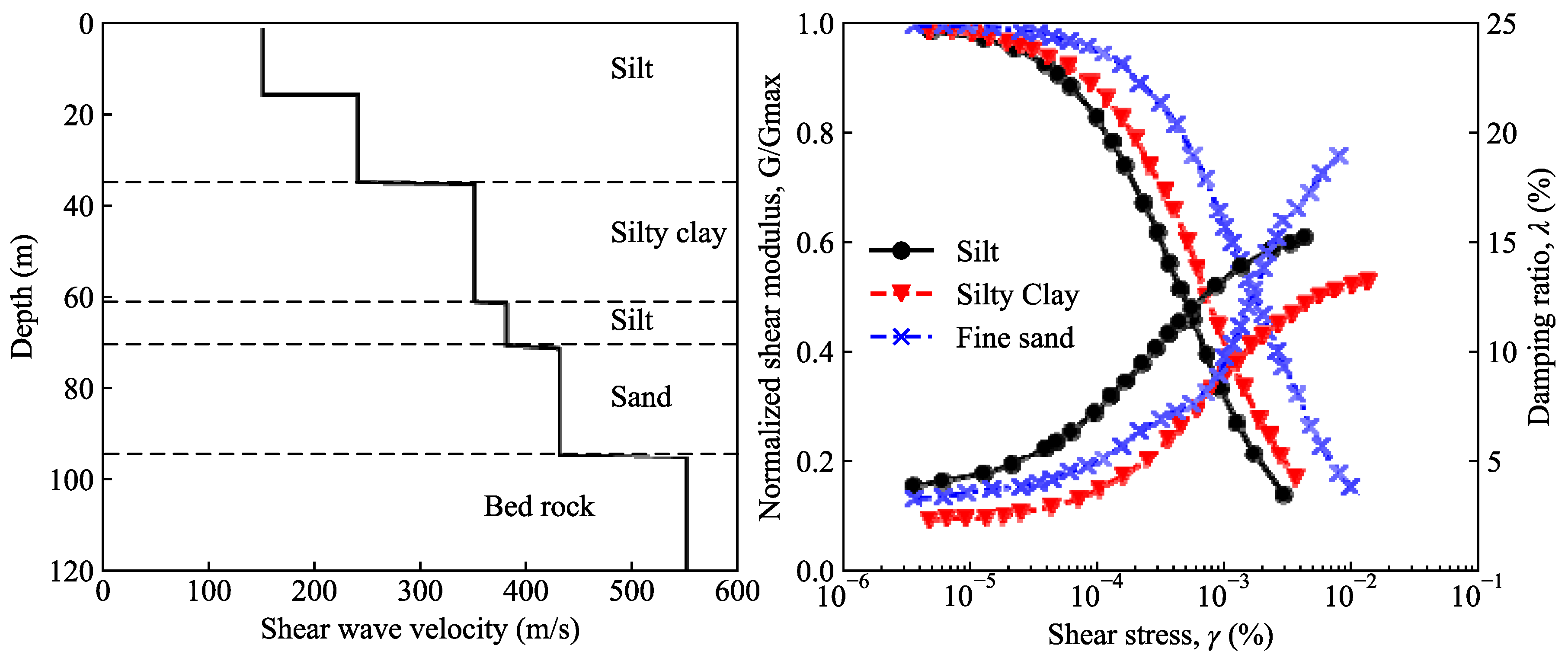

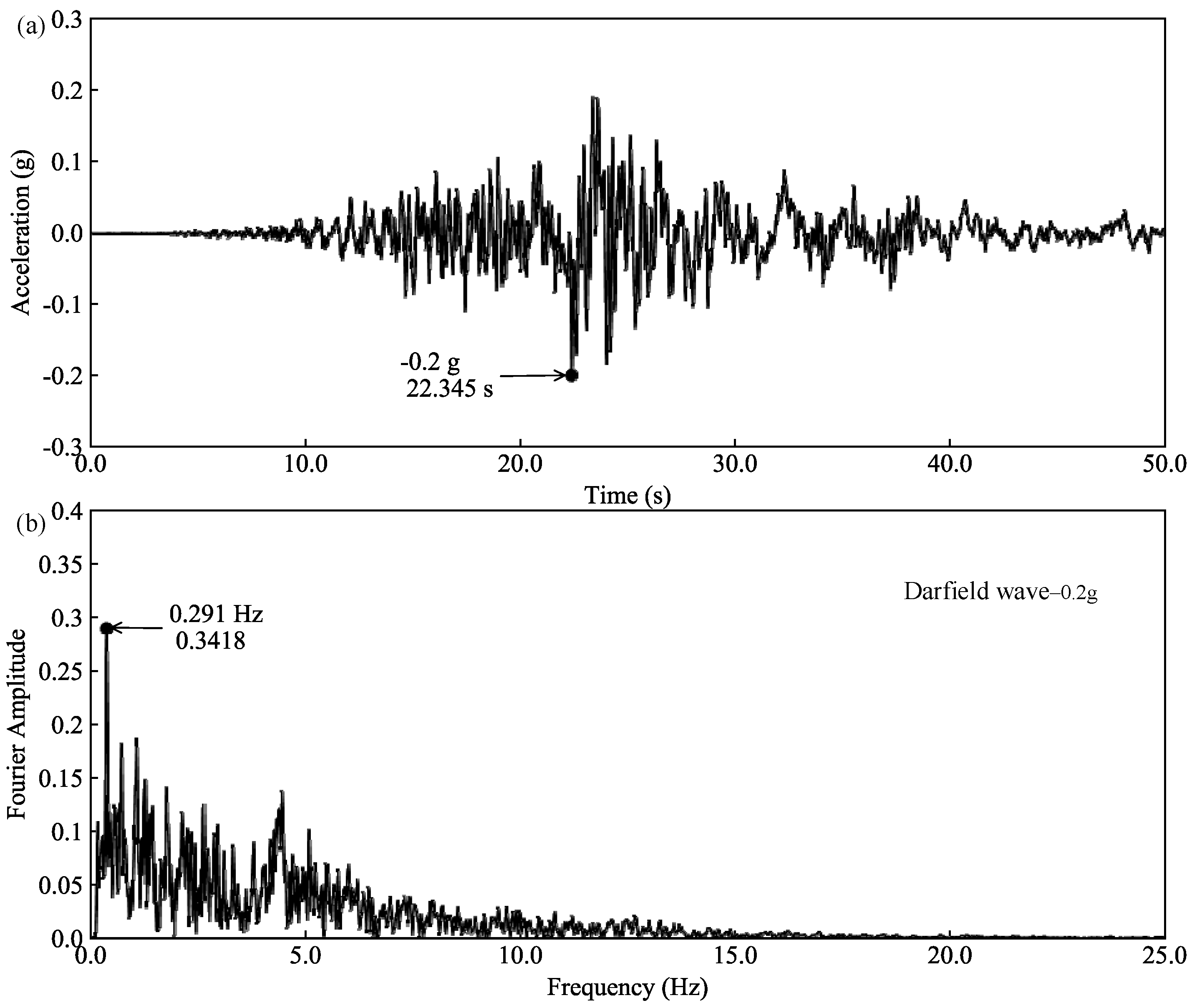
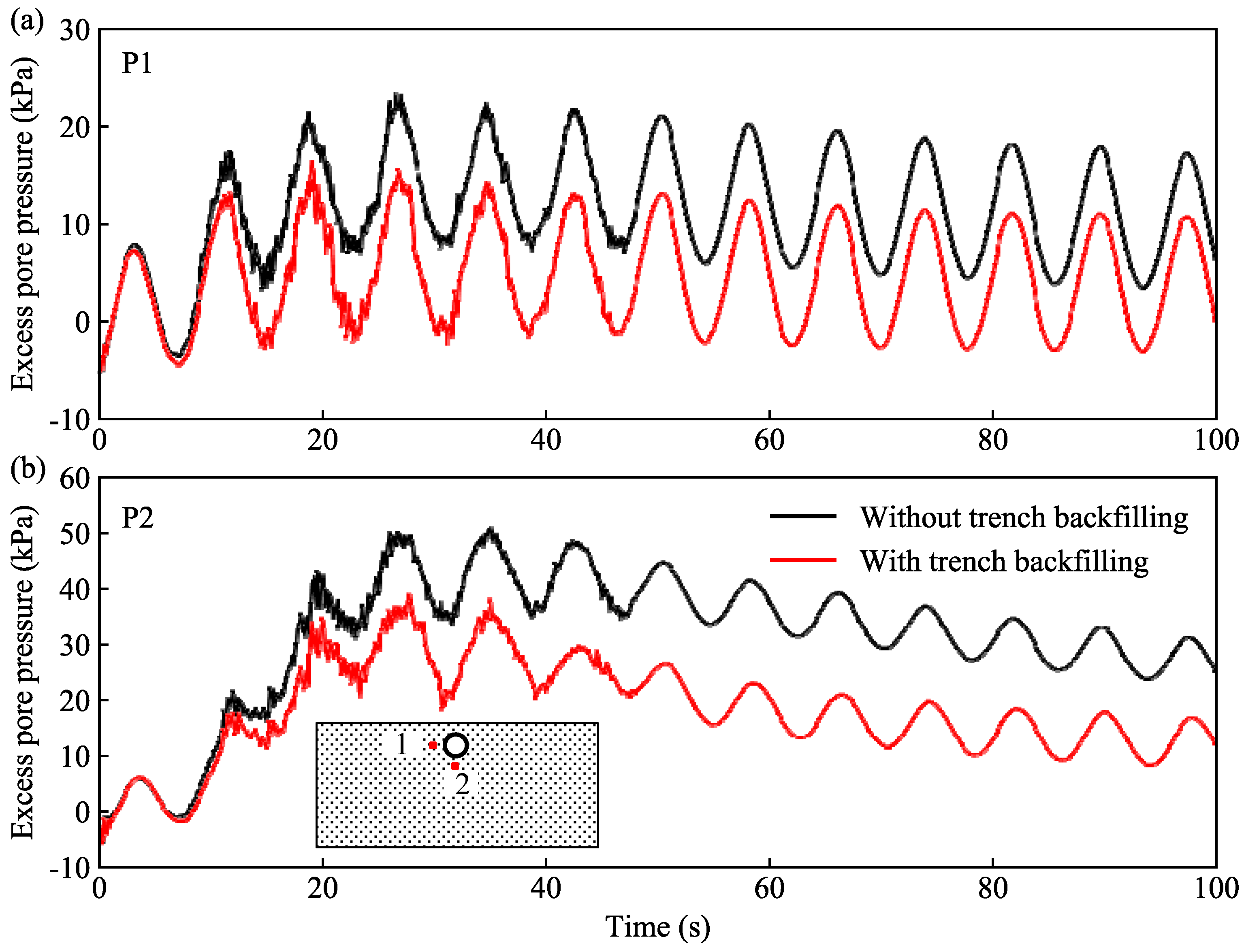

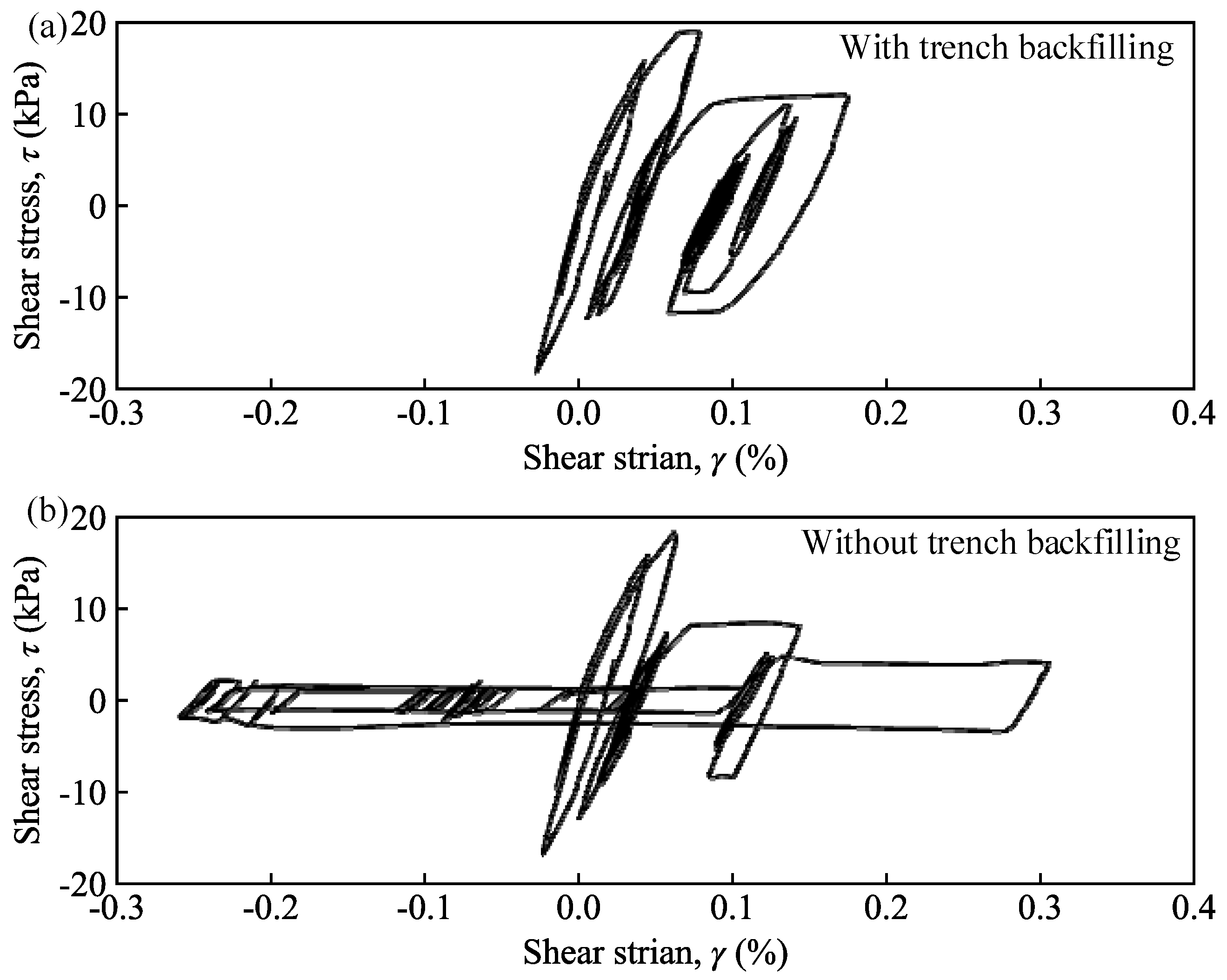
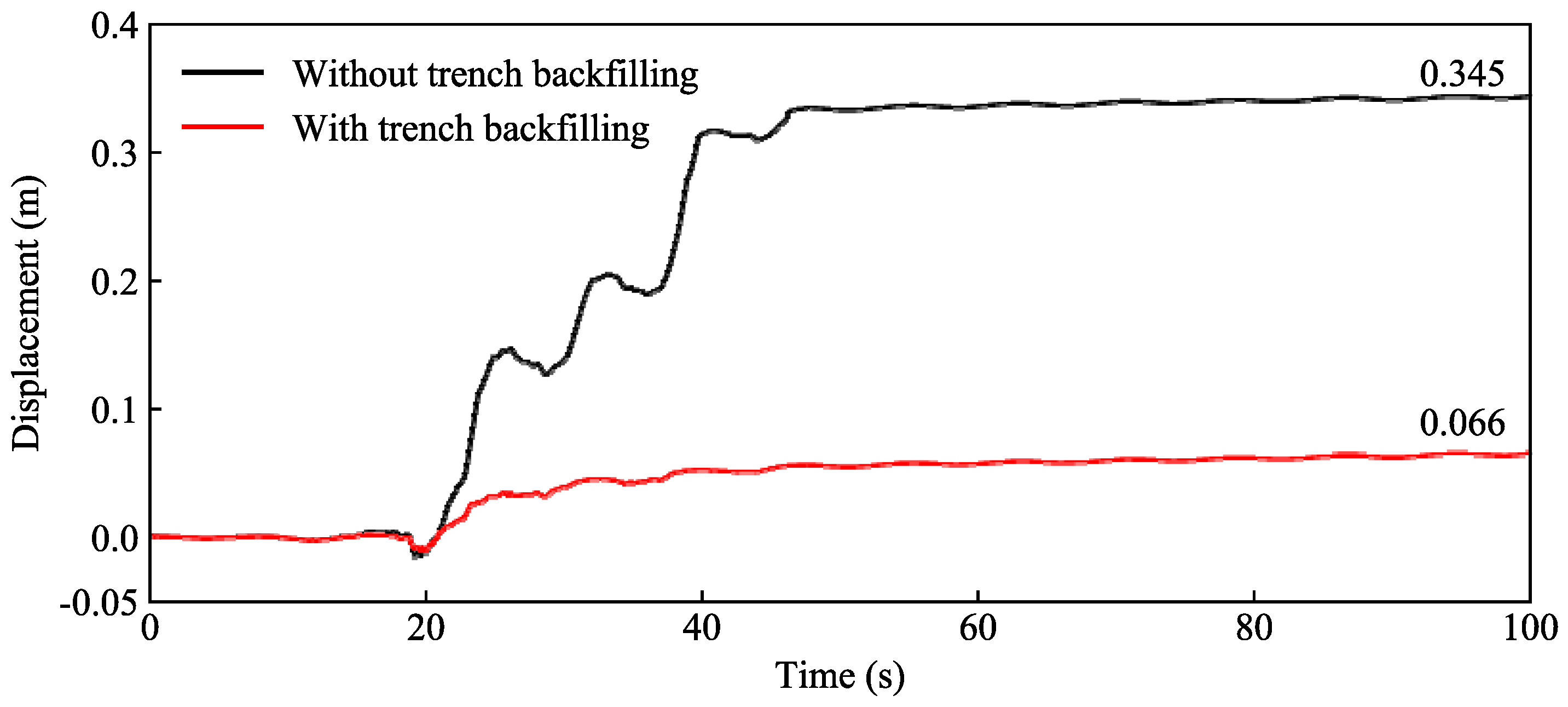
| A | B | C1 | C2 | C3 | c | Ten | ||||
|---|---|---|---|---|---|---|---|---|---|---|
| 50 MPa | 0.3 | 1.02 | 0.35 | 4 × 10−4 | 0.43 | 0.93 | 1.01 | 0 | 30° | 0 |
| Characteristics | Silt | Silty Clay | Fine Sand | Trench Backfilling |
|---|---|---|---|---|
| Soil porosity (ns) | 0.50 | 0.35 | 0.50 | 0.50 |
| Poisson’ ratio (ν) | 0.30 | 0.25 | 0.25 | 0.30 |
| 6.5 × 104 (kN/m2) | 3 × 104 (kN/m2) | 8 × 104 (kN/m2) | 6.5 × 104 (kN/m2) | |
| Soil permeability (k) | 10−5 (m/s) | 10−8 (m/s) | 10−4 (m/s) | 10−4 (m/s) |
| Coefficient of lateral earth pressure (K0) | 0.42 | 0.42 | 0.42 | 0.42 |
| Submerged specific weight of soil | 10 (kN/m3) | 8 (kN/m3) | 12 (kN/m3) | 12 (kN/m3) |
| Degree of saturation (Sr) | 1 | 1 | 1 | 1 |
| Relative density (Dr) | 50% | 60% | 70% | 50% |
| Davidenkov Model | ||||
| A | 1.03 | 0.96 | 1.02 | 1.03 |
| B | 0.50 | 0.47 | 0.48 | 0.50 |
| (×10−4) | 1.80 | 7.30 | 17.90 | 1.80 |
| C1 | 0.43 | -- | 0.67 | 0.43 |
| C2 | 0.93 | -- | 0.6 | 0.93 |
| C3 | 1.10 | -- | 1.25 | 1.10 |
| Mohr–Coulomb model | ||||
| Cohesive strength (c) | 0 | 5 kPa | 0 | 0 |
| Internal friction angle (ϕ) | 30° | 25° | 35° | 30° |
| Tensile strength (Ten) | 0 | 0 | 0 | 0 |
| Young’s Modulus (E) | Poisson’s Ratio (ν) | Density (ρ) | Buried Depth (h) |
|---|---|---|---|
| 2 × 1011 (kN/m2) | 0.25 | 7800 (kg/m3) | 2 m |
| Wave Height (H) | Wave Period (T) | Water Depth (d) | Current Speed (v) |
|---|---|---|---|
| 6 (m) | 6 (s) | 10 (m) | 1 (m/s) |
Publisher’s Note: MDPI stays neutral with regard to jurisdictional claims in published maps and institutional affiliations. |
© 2022 by the authors. Licensee MDPI, Basel, Switzerland. This article is an open access article distributed under the terms and conditions of the Creative Commons Attribution (CC BY) license (https://creativecommons.org/licenses/by/4.0/).
Share and Cite
Wang, Q.; Bian, J.; Huang, W.; Lu, Q.; Zhao, K.; Li, Z. Seabed Liquefaction around Pipeline with Backfilling Trench Subjected to Strong Earthquake Motions. Sustainability 2022, 14, 12825. https://doi.org/10.3390/su141912825
Wang Q, Bian J, Huang W, Lu Q, Zhao K, Li Z. Seabed Liquefaction around Pipeline with Backfilling Trench Subjected to Strong Earthquake Motions. Sustainability. 2022; 14(19):12825. https://doi.org/10.3390/su141912825
Chicago/Turabian StyleWang, Qiuzhe, Jiang Bian, Wenting Huang, Qingrui Lu, Kai Zhao, and Zhaoyan Li. 2022. "Seabed Liquefaction around Pipeline with Backfilling Trench Subjected to Strong Earthquake Motions" Sustainability 14, no. 19: 12825. https://doi.org/10.3390/su141912825
APA StyleWang, Q., Bian, J., Huang, W., Lu, Q., Zhao, K., & Li, Z. (2022). Seabed Liquefaction around Pipeline with Backfilling Trench Subjected to Strong Earthquake Motions. Sustainability, 14(19), 12825. https://doi.org/10.3390/su141912825






